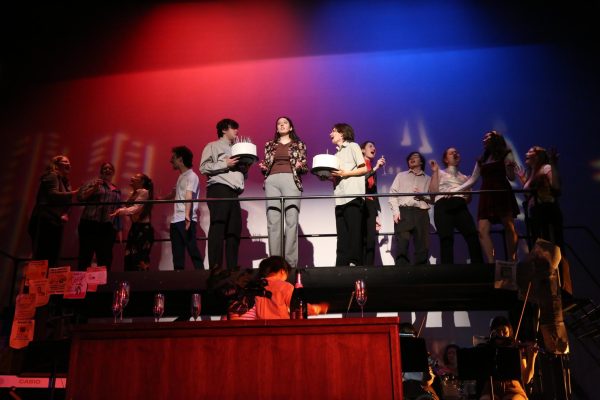What “Her” Tells Us About Technology, Isolation, and Romance
In the context of our tech-driven, transient world, “Her” reveals increasingly important truths.
This year marks a decade since the release of Her, a science-fiction romance starring Joaquin Phoenix and Scarlett Johansson. Spike Jonze, otherwise known for cult classics like 2008’s Synecdoche, New York, directed, wrote, and produced Her, molding the genre of romance to his unashamedly honest style. The film follows the course of a relationship between Theodore (Phoenix), a recently divorced and socially isolated man, and Samantha (voiced by Johansson), his computer’s new operating system (OS). Although Samantha exists solely as a disembodied voice, Johansson’s subtle acting imbues the character with a humanity that creates the convincing illusion of a real relationship developing on-screen.
First and foremost, Her is about loneliness. In one of the very first lines of dialogue, Theodore asks his OS to “play a melancholy song.” This humorously heavy-handed comment provides insight into Theodore’s internal state and establishes a sense of isolation and longing that permeates the rest of the film. This sense is aided by an achingly beautiful soundtrack and Jonze’s directorial choices, which keep Theodore visually isolated, whether through the color of his dress (he’s the only character who wears red) or through his position as the only character on-screen. As Samantha and Theodore’s romance develops, the audience is led to wonder whether this lonely tone might change, but the contrast Jonze creates between the warmth of the couple’s relationship and the emptiness of the on-screen space asserts that Theodore’s melancholy cannot be so easily cured.
Her’s romance confronts the role technology plays in our interpersonal relationships. A unique strength of this film is its choice not to address the question of the morality of conscious technology. By ignoring this question of morality, Her sets itself apart from the subgenre of films like Blade Runner; I, Robot; and Ex Machina. Rather than concerning itself with the existential ethics of conscious AI, Her uses technology to redefine the nature of relationships and explore the boundaries of what constitutes true love.
The futuristic Los Angeles in which this romance is set features technology that doesn’t compete with humans but rather serves to make their lives easier. As Theodore’s new OS, Samantha takes on this charge, filling the roles of secretary, confidante, entertainer, and therapist. She is accessible at all hours and provides him with assistance and companionship in a way that no human being could. Though it’s unclear whether Samantha’s artificial consciousness allows her to love Theodore in the human sense, the relationship the two develop is incontestably romantic. As the characters progress from friendship to flirtation to romance, the audience sees Theodore develop real feelings for Samantha, but, more surprisingly, we also see his desires for human intimacy actually being fulfilled. After ending a long-term relationship, Theodore’s friend, Amy, develops a similarly codependent friendship with her own OS. This reveals that the emotional and organizational support Samantha provides to Theodore may not be unique. Rather, it suggests that some aspect of the OS’s design renders it exceptionally capable of fulfilling both romantic and platonic human needs. Despite the doubt this casts on the genuineness of their relationship, Samantha undeniably changes Theodore for the better. As their relationship progresses, Theodore emerges from isolation and spends more time with Amy and other friends. Rather than causing him to retreat into himself, Samantha stimulates Theodore’s willingness for human connection and his appreciation for life in a way entirely contrary to expectation.
The humanness of Samantha’s interactions with Theodore, his friends, and even children, lulls us into a sense of near normalcy that’s only interrupted when Catherine, Theodore’s ex-wife, calls out the strangeness of the relationship. Theodore responds defensively, but Catherine’s revulsion isn’t unwarranted. As positive as Theodore and Samantha’s relationship may be, the complications inevitably reveal themselves in Samantha’s desire for a sexual surrogate, Theodore’s panic when Samantha is momentarily inaccessible to him, and several other instances. Their relationship is pitiful and vaguely perverse in a way that shows that, despite the positive impact Samantha may have on Theodore’s well-being, their relationship is not made to last.
Though Theodore is the first to realize his and Samantha’s incompatibilities, the decision to cut off their relationship is ultimately made by the OS. She realizes that human relationships are defined as much by their constraints as they are by their benefits. As hard as she may try, Samantha’s nature as a programmed consciousness precludes the imperfection, transience, and singularity of a “real” relationship. In ending Theodore and Samantha’s relationship, Her asserts the irreplaceability of human connection without condemning the involvement of technology in our lives. This conclusion remains relevant, especially in light of the physical isolation we’ve collectively experienced over the past few years. Given the ever-increasing importance of technology as a means of social correspondence, Her warns us not to overlook the significance of physical touch in fostering human connection and, conversely, not to overlook the subtleties of technology’s role in our lives. Along with Theodore, we come to realize that, though technology’s influence can’t be generalized as either good or bad, it is neither a substitute for, nor a solution to, our fundamental need for love and belonging.
In Her’s final scene, Theodore sits with Amy on a roof overlooking the L.A. skyline. Both of their OS companions have left them, and Theodore is once again heartbroken and alone. Though his melancholy remains, we know that he is fundamentally changed. As the sun rises behind the twinkling city lights, Amy rests her head on his shoulder, and the film ends with the reminder that most people are only briefly part of our lives and the reassurance that our capacity for human connection is never truly lost.
Your support will ensure that we can continue producing powerful, honest, and accessible reporting that serves the University of Chicago and Hyde Park communities.






